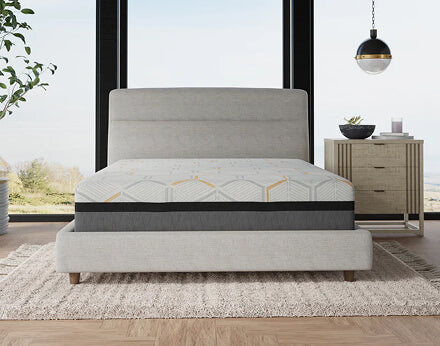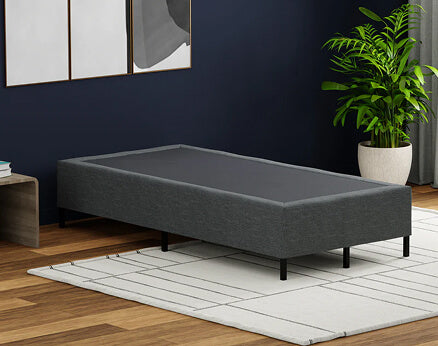A hybrid mattress combines foam's conformity with the innerspring's bounce and breathability. It has a coil support system under a 3-inch thick comfort layer of foam, latex, or polyfoam. Hybrids provide pressure relief, ease of movement, and strong edge support, appealing to various sleep styles. We'll explore their construction, materials, and performance, along with considerations like cost, lifespan, and pros/cons, helping you choose the ideal mattress for your needs.
Hybrid Mattress Construction
A hybrid mattress combines a foam comfort system with an innerspring support core. The comfort layer may consist of memory foam, latex, polyfoam, microcoils, or a blend of these materials.
Metal coils in the innerspring support core vary in type, thickness, and quantity, shaping the overall feel and performance of the mattress. Hybrid mattresses often pocket these coils to improve motion isolation, and they commonly attain zoned support and a reinforced perimeter by incorporating coils of different sizes in the support core.
Some mattress manufacturers may label all-foam beds incorporating latex and memory foam layers as hybrids. However, technically, these beds do not qualify as hybrids since they lack an innerspring core.

Types of Hybrid Mattresses
The performance of a hybrid mattress can differ based on its construction and materials. The comfort layer of a hybrid mattress may include various options, such as:
- Memory foam: Memory foam mattress molds to the body and alleviates pressure from sensitive areas.
- Polyfoam: Polyfoam offers moderate conforming support and a firmer sleep surface than memory foam.
- Latex: Latex provides sleepers a responsive feel while still contouring to the body.
- Microcoils: Microcoils, which are small metal coils located beneath the top comfort layer, offer improved breathability and support.
Hybrid mattresses usually feature a support core of pocketed coils, also known as Marshall coils. These individually wrapped coils move independently, responding to weight shifts without transferring motion to other coils. This design reduces the likelihood of disturbing a sleeping partner when moving or getting in and out of bed.
Mattress shoppers may come across other coil types that are less common in hybrid beds, including:
- Bonnell coils: These hourglass-shaped coils are interconnected and move as a unit.
- Offset coils: Similar to Bonnell coils, offset coils enhance motion isolation.
- Continuous coils: Rows of coils formed with a single wire; continuous coils provide durable support but may allow for more motion transfer.
Hybrid Mattress Vs. Memory Foam
When comparing hybrid vs foam mattresses, it's important to understand their key differences. Foam mattresses are manufactured without the use of any coils. The foam category includes synthetic and natural foams, and certain mattresses may combine these types.
Although NASA initially developed memory foam, different formulations have become widely used in pillows, cushions, and mattresses. This is because memory foam molds to your body as it responds to your body heat, providing even support to your spine during sleep and minimizing motion transfer. However, one drawback is that memory foam can trap heat, which may not be ideal for individuals who tend to sleep hot.
On the other hand, other foam mattresses, such as latex, do not conform as closely to the body and can be a suitable option for sleepers who prefer not to sink into their mattress or prioritize eco-friendly materials.
Hybrid mattresses typically include memory foam layers in addition to traditional innerspring. This combination allows sleepers to enjoy the benefits of both mattress types: the sturdy support provided by coils and the plush feel of memory foam.
Hybrid Mattress Vs. Innerspring
In a traditional spring mattress, there is typically no foam layer included. Instead, the mattress consists of a classic arrangement of metal springs, which form the main structure underneath a cover and thin layers of foam or padding. The presence of these metal springs gives traditional spring mattresses a bouncy sensation, especially when sharing the bed with a partner or pet who frequently moves around. Hybrids address this issue by incorporating foam layers that help minimize motion transfer while retaining the supportive benefits of innerspring.
Benefits of Hybrid Mattresses
- Enhanced Support and Comfort: Hybrid mattresses, combining springs and cushions, cater to various sleeping styles and body types. They offer superior support and adaptability compared to traditional innerspring and memory foam options.
- Edge Support: Hybrid mattresses provide reliable edge support, ensuring you stay supported even towards the bed's edges.
- Pressure Relief: Individual pocket coils in hybrid mattresses adapt to your body's shape and sleeping style, delivering effective pressure relief whether you're a side or back sleeper.
- Motion Isolation: Ideal for couples, hybrid mattresses excel in motion isolation, thanks to individually wrapped coils and layers of foam and gel that minimize motion transfer during sleep.
- Breathability: Combining individual coils and layers enhances the breathability of hybrid mattresses, allowing air circulation and promoting a cooler sleep environment.
- Durability: With multiple layers and components, hybrid mattresses boast exceptional durability, making them a long-lasting investment. While they may cost more than traditional innerspring mattresses, their extended lifespan can justify the investment, potentially lasting over a decade with proper care.
Hybrid Mattress Components
- Innerspring Coils (Support): Individually wrapped and pocketed coils in a hybrid mattress move with your body, minimizing motion transfer during sleep.
- Comfort Layers: These layers can consist of memory foam, micro-coils, latex, polyfoam, or a combination, depending on the manufacturer. Some hybrids may include a cooling layer made of gel to regulate body heat.
- Transition Layers: Placed between the supportive coils and the soft comfort layer, transition layers, often made of foam, provide a padded buffer for added support and stability.
- Cover Materials: A cover enhances mattress life and comfort for a hybrid or any other mattress. Typically made of cotton, poly-blend, or wool, mattress covers protect against dust, dirt, and fluids. Removable and washable, it's essential to follow care instructions on the tags.
How to Choose a Hybrid Mattress
Selecting the right mattress is a decision that should align with individual needs and preferences. It's crucial to consider factors such as body type, sleep position, and budget. We are here to help you determine the ideal hybrid mattress
Body Type
Different hybrid mattresses will feel and perform differently based on body type and weight. Comfort levels vary for each sleeper, and what suits one person may not be comfortable for another. We categorize body types into three groups:
- People under 130 pounds: Sleepers in this category generally require a softer comfort layer for the best pressure relief.
- Individuals between 130 and 230 pounds: Sleepers in this range generally prefer a combination of contouring and support in their mattresses.
- People over 230 pounds: Sleepers tend to sink deeper into the mattress and may need additional support provided by a firm sleeping surface and a coil support core.
Sleeping Position
Your sleeping position affects the support required for pressure relief and spinal alignment. Body type and personal preferences also influence your decision to select the best mattress type for each sleeper category.
- Side sleepers: They often benefit from a thicker comfort layer that offers moderate contouring to cushion the hips and shoulders. A surface that is too firm may not adequately relieve pressure points. The coil support core maintains proper spine alignment by providing pushback and responsiveness.
- Back sleepers: Ensuring a neutral spine alignment is essential, and an ideal mattress conforms to the lower back while preventing excessive sinking of the hips and shoulders. Soft memory foam comfort layers may not provide sufficient support, and a hybrid with zoned coils can offer extra lumbar support.
- Stomach sleepers: Firm surfaces work best for stomach sleepers, as memory foam comfort layers may be too soft. Latex and polyfoam comfort layers provide better support by promoting spinal alignment.
Firmness
We rate the mattress firmness from 1 to 10, with 1 being extra soft and 10 being extra firm. Your body type and sleep position determine how much you sink into the mattress and its firmness. For instance, a side sleeper under 130 pounds may find a medium mattress lacking in adequate pressure point relief, while a stomach sleeper over 230 pounds may experience excessive sinkage on a medium-firm model.
Body Pain
Those experiencing body pain may find that a hybrid mattress's balance of contouring and support can help alleviate discomfort. With many options available, people with neck, back, or hip pain can find different materials and firmness levels to suit their specific needs. Pocketed coils in many hybrid mattresses support individual body parts by responding to pressure. Zoned support cores offer targeted support to relieve aches and pains.
Budget
Considering that a twin hybrid mattress is a significant investment, it's important to carefully assess your sleep when determining a budget for a new one. Hybrid mattresses generally come at a higher price than other types, but models are available across various price ranges. Many manufacturers also offer sales and discounts to cater to value mattress shoppers.
Hybrid Mattress FAQs
Is a hybrid mattress good for back pain?
Absolutely! Hybrid mattresses are an excellent choice for individuals dealing with back pain or discomfort due to their unique combination of contouring capabilities and a supportive core section. While certain individuals with back pain may prefer a firmer sleep surface, there are hybrid mattresses that cater to the needs of those experiencing back issues.
Who should get hybrid mattresses?
Hybrid mattresses offer comfort and support for side, back, and stomach sleepers. They are beneficial for joint and back health, and some include a cooling gel layer for temperature regulation. Though they may be pricier, their exceptional features make them worth considering.
What is the average lifespan of hybrid mattresses?
Similar to other bedding products, such as mattresses, proper maintenance is important for maximizing the longevity of a hybrid mattress. On average, hybrids typically have a lifespan of around eight to ten years.
What is the average price of a hybrid mattress?
The average cost of a hybrid mattress can vary depending on size, manufacturer, and the number of comfort and transitional layers it possesses. For instance, a hybrid queen mattress typically falls within the price range of $1500 to $2000 or more.
Is a Hybrid Mattress Worth It?
Hybrid mattresses are a perfect choice for many sleepers, although they tend to be more expensive than traditional spring or foam-only mattresses. However, the higher price tag associated with hybrid mattresses often reflects the inclusion of additional features or premium materials, providing a more luxurious sleeping experience.



















Leave a comment
This site is protected by hCaptcha and the hCaptcha Privacy Policy and Terms of Service apply.